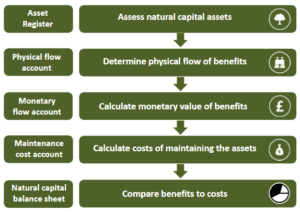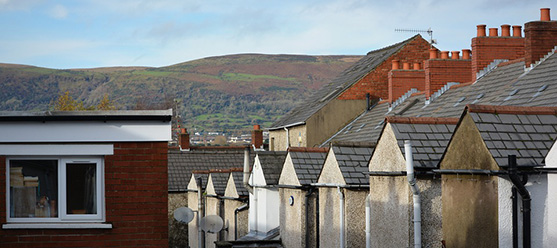Natural capital is defined as “...elements of nature that directly or indirectly produce value or benefits to people, including ecosystems, species, freshwater, land, minerals, the air and oceans, as well as natural processes and functions” (UK Natural Capital Committee, 2014). These benefits (often referred to as ecosystem services) include food production, regulation of flooding and climate, pollination of crops, and cultural benefits such as aesthetic value and recreational opportunities. Using a natural capital assessment (figure 1), it is possible to understand the extent and condition of those assets, so the flow of ecosystem service benefits from those assets can be established and valued.
(Image: Sunflower with Bee) With particular thanks to Oliver Hellowell, Professional Landscape & Wildlife photographer (who just happens to have Down Syndrome) www.oliverhellowell.com


Fig 1: The Natural Capital Assessment Approach
The natural capital approach demonstrates the value of the natural environment to society and the importance of investing in and protecting our finite stock of natural assets. Yet not all the values associated with nature can be monetised, which presents an ongoing challenge for the way in which natural capital tools and methodologies are developed. However, the approach has great potential to advance the way in which the value of nature and our long–term prosperity is reflected in decision–making.
Natural Capital Pilots
With natural capital commitments featured in the Draft NI Programme for Government, the Department for Agriculture, Environment and Rural Affairs has supported NIEL to commission pilot natural capital assessments and assess how the natural capital approach can move from policy into practice. This policy agenda specifically responds to the guidance offered by the UK Natural Capital Committee (2017) which recognises the need for ‘pioneer projects to test different initiatives’ which can help move the natural capital agenda ‘from aspiration to practical delivery’.
The first pilot project successfully applied the natural capital approach to two urban sites in Northern Ireland, namely Bog Meadows and Minnowburn. As well as advancing the understanding of the importance and practicalities of undertaking Natural Capital assessments, the pilots reveal the range and scale of benefits that these areas, and those who manage them, provide to the public. The second pilot project applied a natural capital approach to CAFRE owned and managed farms.
The reports from both pilots can be viewed here:
- Interserve Consulting – Natural Capital Assessment in Northern Ireland: Rural Study – Report
- Dr Jim Rouquette et al – Natural Capital Assessment in Northern Ireland: Urban Study – Presentation
- Dr Jim Rouquette et al – Natural Capital Assessment in Northern Ireland: Urban Study – Report
- Prof Paul Leinster – Accounting for the environment in Northern Ireland – Presentation
The Way Forward
The natural capital approach is straightforward and transparent and can have a powerful and positive influence on decision–making. First, natural capital assessments can inform the development of investment plans for strategic locations. Second, they can inform development and land use–planning decisions through their integration into Local Development Plans and policies, helping to determine the most appropriate locations for development. Third, they can form part of a natural capital and biodiversity net gain policy to ensure all new developments achieve net benefits for people and the environment. Finally, assessments could inform the calculation of agricultural support payments, which is timely in the context of Brexit.

Links
- Blog: Embedding a Natural Capital Approach; from Policy to Practice
- Revaluing Parks and Green Spaces – Measuring their economic and wellbeing value to individuals
- Manchester’s urban natural capital pioneer project
- Natural Capital Committee (NCC)
- Natural Capital Ireland
- Natural Capital Scotland
- Ecosystems Knowledge
Interested in becoming a member?
The key aspect of NIEL membership is the facility for co–ordinated action, a shared agenda and strong voice for environmental protection.

